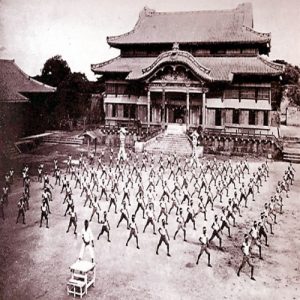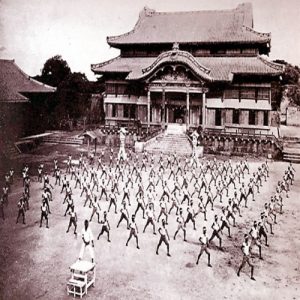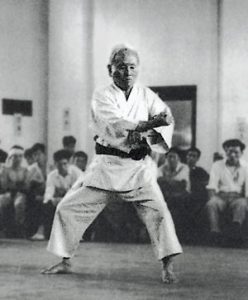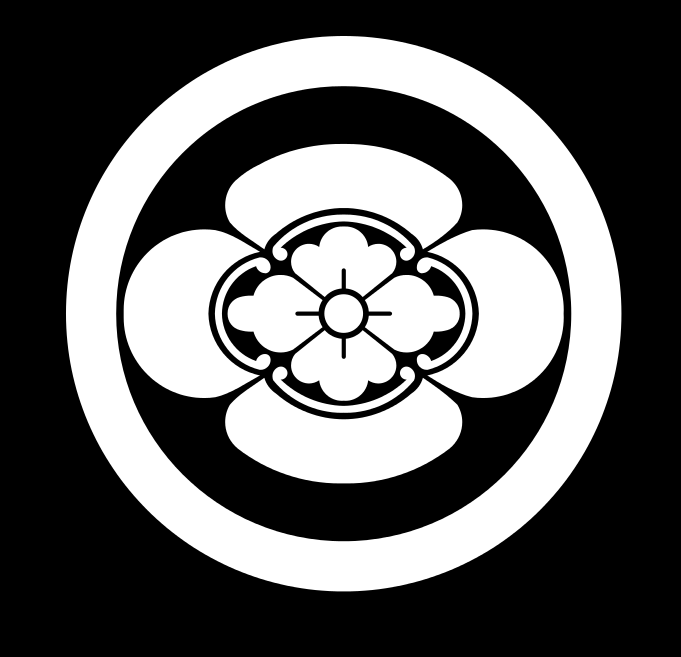The History of Karate



525AD during the six dynasties of China ( 220-581AD), Bodiharma (Daruma in Japanese) a monk from India, wandered into China for the purpose of spreading Buddhism, ended up at the Shaolin Monastery in Henan province. The Shaolin monks were trained to stay seated for long periods of time practicing meditation. Because of a lack of physical exercise, Daruma introduced organized calisthenics and Yoga into their daily training. This help developed blood flow and stamina needed for hard core meditation. This later develops into Zen Buddhism and Shaolin Gung fu. Mixing his teachings with the indigenous martial arts, the Shaolin monks were inspired to examine the combative movements of birds and beasts over the centuries combine it into a systemize form of self-defense called Shorin-ji Kempo. The monks of the Shaolin Monastery became very famous in both mental and physical strengths and their art spread and expanded into many areas of Asia, including Okinawa (The Ryukyu Islands) and the art was called To-di (Chinese hand).

1368-1644 There was a long history of cultural exchange between China and the Ryukyu Islands dating back to the Ming dynasty. Ti (Hands) was brought over from Ming China. To-di (Chinese hand) was mostly developed and brought over during the Qing dynasty (1644-1912). Karate Okinawan Gung fu spread and developed around the three villages of Shuri, Naha and Tomari, where Chinese influence is greatest. These arts became known as Shuri-te, Naha-te and Tomari-te for the area in which it was practices. The arts from Shuri and Tomari became known as Shorin ryu Shaolin temple style and the arts from Naha became known as Shorei ryu Enlighten Spirit styleMaster Gichin Funakoshi brought Shorin ryu to main land Japan and it developed into Modern Shotokan Karate-do. Shorei ryu develop on Okinawa and became the styles of Kojo ryu, Goju ryu and Uechi ryu.


1932 meeting of Goju-Ryu Founder Master Chojun Miyagi (C)
and Shotokan-Ryu Founder Master Gichin Funakoshi (R)

Original Shuri Castle pre-WWII
Modern Shuri Castle after restoration


Master Gichin Funakoshi
 Master Gigo Funakoshi
Master Gigo Funakoshi
 Master Tomosaburo Okano
Master Tomosaburo Okano
 Master Toyotaro Miyazaki
Master Toyotaro Miyazaki

1922 Master Tomosaburo Okano was born in Hachioji-shi Tokyo, Japan. Later Master Okano was designated a living national treasure for karate by the Japanese government.
1868 Master Gichin Funakoshi Shoto as he was known, was born in Naha Okinawa and as a young child began learning To-di from Master Anko Azato of Naha and Master Anko Itosu of Shuri. Masters Asato and Itosu were disciples of the great Okinawan Martial Artist, Sokon Matsumura who was himself a disciple of Kanga Sakugawa and three Chinese Military attaches, Wai shin Zan, Ason and Iwah.
1917 Master Funakoshi performed the first public demonstration of Karate outside of Okinawa at the Butokuden Martial art center in Kyoto Japan.
1921 Master Funakoshi demonstrated Karate at Okinawa’s Shuri castle for Hirohito the Crown Prince of Japan. The Prince ( Future Emperor of Japan) was so impressed that he wanted the art to be introduce to Mainland Japan.
1922 The Master moved to Japan and permanently settle down in Koishikawa Tokyo and started teaching at the Meisei juku (dormitory for Okinawan Students).
1922 Master Funakoshi performed public Karate demonstrations in Tokyo and introduced the Okinawan art to the general public.

Master Tomosaburo Okano History
1922 Master Funakoshi wrote the first textbook on Karate called Ryukyu kempo To-di (meaning, Okinawan fist method China hand).
1924 Master Funakoshi started to teach at Keio University karate club and later many other University karate clubs were formed.
1925 Master Funakoshi wrote Rentan Goshin To-di jitsu (meaning, physical fitness self-defense China hand art).
1929 Master Funakoshi change the name of his martial art to Karate-do (way of the Empty hand).
1935 Master Funakoshi wrote karate-do Kyohan, using the new term for karate (meaning, way of the empty hand, master text).
1936 Master Gichin Funakoshi with the help of his students formed the Dai Nihon Karate-do Shotokai meaning Great Japan empty hand way pine wave association .
1936 Master Funakoshi became the founding Kaicho president and Shihan Master Instructor of the association and Gigo Funakoshi also known as Yoshitaka Funakoshi became the Shihan-dai assistant to the Master .
1939 With the help of the Dai Nihon Karate-do Shotokai members, funds was raise to built the karate dojo of Master Funakoshi. The dojo was call the Shotokan (meaning pine wave building), The dojo was built next to his home in Mejiro Tokyo, (formally inaugurated on January 29, 1939). The style of karate became known as Shotokan ryu.
1941 Master Tomosaburo Okano started karate At 19 years old with Mister Toshio Igarashi, a member of the Pine Wave School.
1942 Mister Igarashi brought and introduced Master Okano to the Shotokan dojo and became a direct student of Master Gichin Funakoshi and his third son, Master Gigo Funakoshi.
1942 On October 10th, Master Okano with the help of Misters Suzuki Shinjo, Kaneko Isamu and Takagi Yoshitomo, established the KenkoKai Karate-Bu a karate research club in Hachioji-shi Tokyo.


1943 Master Funakoshi wrote Karate-do Nyumon (meaning, enter the door to way of the empty hand).
1944 On September 25th, Master Toyotaro Miyazaki was born in Hachioji-shi, Tokyo, Japan.
1945 On April 29th the Shotokan Dojo was destroy during the air raid over Toyko.
1945 On November 24th, Master Gigo Funakoshi died of a long illness. He was 39 years old.
1945 Master Okano returned from the air force and revived the KenkoKai Karate-Bu after the war.
1948 The kenkokai Karate-bu change it’s name to the Kenkojuku Dojo. The Kenkojuku Budokan was established at the present location in Minamimachi.

1949 On May 27th, students headed by Master Masatoshi Nakayama formed the Japan Karate Association (JKA), naming Master Funakoshi as the Technical adviser.
1955 On November 30th, Master Funakoshi and his first and second son visited the Kenkojuku Dojo for a special ceremony.

1957 Master Gichin Funakoshi passed away on April 26th at the age of 88.
1959 Master Toyotaro Miyazaki joined the Kenkojuku dojo and became a top student of Master Okano.

Shotokai Karate-do

1964 Shihan Kai Leung started martial art training and later became a top student and instructor of Shotokan under Master Miyazaki. He is a founding member of the International Shotokai Karate-do Federation and is now the head instructor of the federation.

1967 Master Miyazaki came to America and started teaching the original style of Shotokan. He settle down in New York City area and became the Head instructor of the USA Kenkojuku Shotokan Karate-do Association. He later founded the Japan Karate-do USA Shotokai Karate-do Association and now supervises the International Shotokai Karate-do Federation.
 1976 The Whitestone Dojo was founded by Shihan Kai Leung in Whitestone New York..
1976 The Whitestone Dojo was founded by Shihan Kai Leung in Whitestone New York..

1982 The Shotojuku Dojo was founded by Master Toyotaro Miyazaki and Shihan Kai Leung in Astoria New York.
 2001 On September 23rd, Master Tomosaburo Okano celebrated his 60th anniversary in Karate.
2001 On September 23rd, Master Tomosaburo Okano celebrated his 60th anniversary in Karate.
2002 The Shotojuku Dojo celebrated it’s 20th anniversary.
 2003 Master Tomosaburo Okano passed away on July 19th at the age of 81.
2003 Master Tomosaburo Okano passed away on July 19th at the age of 81.
2007
Shotojuku Honbu Dojo Silver Anniversary
celebrating 25 years of continuous karate instruction
2008
Inauguration of the Miyazaki Karate-Do O.B. Kai.
Founded on August 17, 2008
Our Success Story

Shotokan Karate

Master Tomosaburo Okano History


